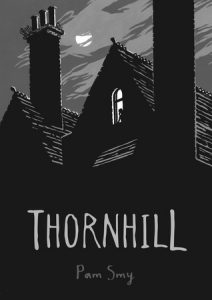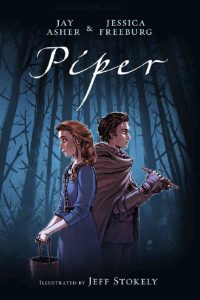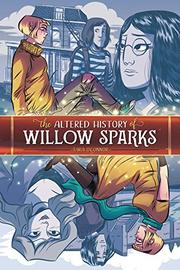Dialing Up the Creepy | New Graphic Titles for Teens
This selection of new and forthcoming graphic novels range in subject and tone—from mildly creepy to spine-tingling.
 What better way to kick off the season than with the work of Edgar Allan Poe? With Poe: Stories and Poems (Candlewick, Aug. 2017; Gr 7 Up), Gareth Hinds adapts several of the master of horror’s well-known works into graphic novel format, judiciously condensing Poe’s prose and relying on arresting imagery to convey drama and menace. Eerie close-ups portray the pale blue “vulture” eye that drives the protagonist of “The Tell-Tale Heart” to murder. The surreal opening of “The Pit and the Pendulum,” a vivid account of torture during the Spanish Inquisition, evokes dizzying fear, with images of a dazed figure etched in white stumbling against a black background. Hinds powerfully wields his palette. Lavish hues of purple, green, and blue give way to crimson when “The Masque of the Red Death” intrudes upon the debauched, secluded court of Prince Prospero, and as the narrator of “The Cask of Amontillado” lures the hapless Fortunato into the wine cellar, the dank setting burns a hellish red. Poe fans will gain a greater appreciation for the writer, and newcomers will want to seek out the source material.
What better way to kick off the season than with the work of Edgar Allan Poe? With Poe: Stories and Poems (Candlewick, Aug. 2017; Gr 7 Up), Gareth Hinds adapts several of the master of horror’s well-known works into graphic novel format, judiciously condensing Poe’s prose and relying on arresting imagery to convey drama and menace. Eerie close-ups portray the pale blue “vulture” eye that drives the protagonist of “The Tell-Tale Heart” to murder. The surreal opening of “The Pit and the Pendulum,” a vivid account of torture during the Spanish Inquisition, evokes dizzying fear, with images of a dazed figure etched in white stumbling against a black background. Hinds powerfully wields his palette. Lavish hues of purple, green, and blue give way to crimson when “The Masque of the Red Death” intrudes upon the debauched, secluded court of Prince Prospero, and as the narrator of “The Cask of Amontillado” lures the hapless Fortunato into the wine cellar, the dank setting burns a hellish red. Poe fans will gain a greater appreciation for the writer, and newcomers will want to seek out the source material.  Ratcheting up the creep factor, Pam Smy’s Thornhill (Roaring Brook, Aug. 2017; Gr 5-9) centers on two isolated girls, separated by 25 years, who forge a connection. In 1982, shy, awkward Mary endures a Dickensian existence at the Thornhill Institute, an orphanage on the verge of shutting down. Tormented by a merciless bully, generally overlooked by oblivious adults, and unable to confide in anyone because of her selective mutism, the girl takes solace in her books, her journal, and her doll making. In 2017, Ella moves in across the street from the now-abandoned Thornhill. With her father buried in work and her mother no longer around, she’s eager for a friend and becomes intrigued by an odd girl she notices in and around Thornhill. Alternating between Mary’s achingly bleak diary entries and grim, wordless black-and-white images of Ella, Smy creates a classic ghost story, tinged with sadness. The illustrations have a gothic flair: crows perch on the forbidding house, warped doll parts litter the yard, and something sinister always seems to lurk out of frame. Though the narrative starts off comfortably spooky, it builds to a ghoulish climax that may upset younger or sensitive readers but will whet the appetites of future Stephen King and Shirley Jackson fans.
Ratcheting up the creep factor, Pam Smy’s Thornhill (Roaring Brook, Aug. 2017; Gr 5-9) centers on two isolated girls, separated by 25 years, who forge a connection. In 1982, shy, awkward Mary endures a Dickensian existence at the Thornhill Institute, an orphanage on the verge of shutting down. Tormented by a merciless bully, generally overlooked by oblivious adults, and unable to confide in anyone because of her selective mutism, the girl takes solace in her books, her journal, and her doll making. In 2017, Ella moves in across the street from the now-abandoned Thornhill. With her father buried in work and her mother no longer around, she’s eager for a friend and becomes intrigued by an odd girl she notices in and around Thornhill. Alternating between Mary’s achingly bleak diary entries and grim, wordless black-and-white images of Ella, Smy creates a classic ghost story, tinged with sadness. The illustrations have a gothic flair: crows perch on the forbidding house, warped doll parts litter the yard, and something sinister always seems to lurk out of frame. Though the narrative starts off comfortably spooky, it builds to a ghoulish climax that may upset younger or sensitive readers but will whet the appetites of future Stephen King and Shirley Jackson fans.  Jay Asher and Jessica Freeburg’s reimagined version of the pied piper story isn’t quite a work of horror. But Piper (Razorbill, Oct. 2017; Gr 6 Up) is sure to provoke chills. To the gossipy, insular inhabitants of Hameln, Maggie’s checkered family history and her deafness (though she can read lips and speak) make her an outcast. A gifted storyteller, the young woman gives the churlish villagers their comeuppance in the disturbing tales she spins for Agathe, her adopted mother. Maggie’s fantasies of a dashing stranger seem to be realized when the town officials hire a piper who claims he can eradicate the plague of rats, but things soon turn nightmarish. Jeff Stokley’s animated, comic book–like visuals rely on lush colors and strong linework. The varied illustrations are appropriately unsettling. By day, bright skies and green meadows give Hameln an idyllic, bucolic look, but nighttime images of the rats writhing in an outhouse or stealing into a baby’s cradle set an ominous tone. As for the piper, he goes from dreamy and doe-eyed to stern and steely-eyed to a smudgy, silhouetted cipher. This gorgeously illustrated, nuanced adaptation adeptly fleshes out the original text, offering a touch of romance and incisive commentary on small-town life.
Jay Asher and Jessica Freeburg’s reimagined version of the pied piper story isn’t quite a work of horror. But Piper (Razorbill, Oct. 2017; Gr 6 Up) is sure to provoke chills. To the gossipy, insular inhabitants of Hameln, Maggie’s checkered family history and her deafness (though she can read lips and speak) make her an outcast. A gifted storyteller, the young woman gives the churlish villagers their comeuppance in the disturbing tales she spins for Agathe, her adopted mother. Maggie’s fantasies of a dashing stranger seem to be realized when the town officials hire a piper who claims he can eradicate the plague of rats, but things soon turn nightmarish. Jeff Stokley’s animated, comic book–like visuals rely on lush colors and strong linework. The varied illustrations are appropriately unsettling. By day, bright skies and green meadows give Hameln an idyllic, bucolic look, but nighttime images of the rats writhing in an outhouse or stealing into a baby’s cradle set an ominous tone. As for the piper, he goes from dreamy and doe-eyed to stern and steely-eyed to a smudgy, silhouetted cipher. This gorgeously illustrated, nuanced adaptation adeptly fleshes out the original text, offering a touch of romance and incisive commentary on small-town life.  The eponymous heroine of Tara O’Connor’s The Altered History of Willow Sparks (Oni, Jan. 2018; Gr 7 Up) flees a group of bullies into the library basement, where she stumbles across a book filled with her life story. The teen realizes that she has the chance to shed her outcast status and uses the book to literally rewrite her future. The new Willow, clear-skinned, athletic, and well dressed, rises in popularity but leaves behind her best friend, Georgia. Even worse, inky, veinlike designs appear on Willow’s skin. O’Connor’s two-toned illustrations feature graceful, flowing linework, and exaggerated character reactions heighten the tension. With its message of self-acceptance and the value of true friendship, this is a predictable narrative but one that will resonate with readers trying on different identities and coping with the stress of high school. A frightening dream sequence and Willow’s desperation at the alarming side effects of her writing are creepy, but this lightly supernatural tale ends on a reassuring note, with lessons duly learned.
The eponymous heroine of Tara O’Connor’s The Altered History of Willow Sparks (Oni, Jan. 2018; Gr 7 Up) flees a group of bullies into the library basement, where she stumbles across a book filled with her life story. The teen realizes that she has the chance to shed her outcast status and uses the book to literally rewrite her future. The new Willow, clear-skinned, athletic, and well dressed, rises in popularity but leaves behind her best friend, Georgia. Even worse, inky, veinlike designs appear on Willow’s skin. O’Connor’s two-toned illustrations feature graceful, flowing linework, and exaggerated character reactions heighten the tension. With its message of self-acceptance and the value of true friendship, this is a predictable narrative but one that will resonate with readers trying on different identities and coping with the stress of high school. A frightening dream sequence and Willow’s desperation at the alarming side effects of her writing are creepy, but this lightly supernatural tale ends on a reassuring note, with lessons duly learned. For other similar graphic novels, see Mahnaz Dar's "Walk On the Weird Side," published in an earlier issue of Curriculum Connections.
Add Comment :-
RELATED
RECOMMENDED
CAREERS
The job outlook in 2030: Librarians will be in demand
CAREERS
The job outlook in 2030: Librarians will be in demand
ALREADY A SUBSCRIBER? LOG IN
We are currently offering this content for free. Sign up now to activate your personal profile, where you can save articles for future viewing





